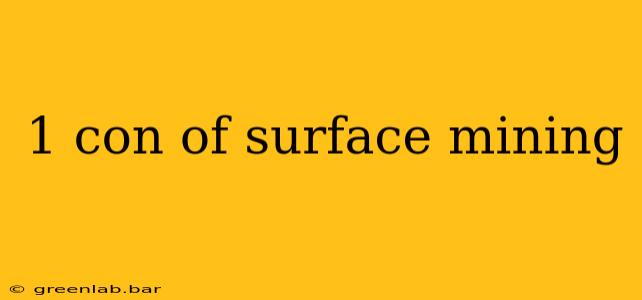Surface mining, while efficient for extracting large quantities of resources like coal, minerals, and aggregates, carries significant environmental consequences. The most devastating drawback is its severe impact on landscapes and ecosystems. This single negative aspect encompasses a multitude of interconnected problems, making it arguably the most significant concern surrounding this extraction method.
Habitat Destruction and Biodiversity Loss
One of the primary ways surface mining devastates landscapes is through complete habitat destruction. The process often involves removing topsoil, vegetation, and entire hillsides, leaving behind barren, scarred land. This obliterates existing ecosystems, displacing or killing countless plants and animals. Endangered species are particularly vulnerable, facing population declines or even extinction due to habitat loss. The scale of this destruction can be immense, affecting vast areas and creating long-lasting impacts on biodiversity.
The Ripple Effect on Ecosystem Services
The loss of biodiversity isn't just an aesthetic issue; it significantly impacts ecosystem services. These are the essential benefits humans derive from healthy ecosystems, including clean water, air purification, pollination, and climate regulation. Surface mining disrupts these vital processes, potentially leading to water contamination, soil erosion, increased greenhouse gas emissions, and a decline in overall environmental health. The consequences can extend far beyond the immediate mining site, impacting surrounding communities and regions.
Soil Degradation and Erosion
The removal of topsoil during surface mining leads to severe soil degradation. Topsoil is crucial for plant growth and nutrient cycling, and its loss renders the land infertile for decades, if not centuries. The exposed subsoil is highly susceptible to erosion, leading to sediment runoff into waterways, damaging aquatic habitats and potentially contaminating drinking water sources. This erosion also contributes to air pollution through dust storms, negatively impacting air quality and human health.
Long-Term Rehabilitation Challenges
While reclamation efforts are often undertaken after mining ceases, restoring a mined landscape to its pre-mining condition is extremely challenging and often incomplete. The process is time-consuming, expensive, and may not fully reverse the environmental damage. Rehabilitated areas may lack the biodiversity and ecosystem functionality of the original habitat, leading to long-term ecological consequences. The success of reclamation efforts heavily depends on factors such as climate, soil type, and the availability of funding and expertise.
Conclusion: A Multifaceted Environmental Threat
The devastating impact on landscapes and ecosystems isn't just one con of surface mining; it's a multifaceted problem encompassing habitat destruction, biodiversity loss, soil degradation, erosion, and long-term rehabilitation challenges. Addressing this significant environmental threat requires stringent regulations, advanced reclamation techniques, and a shift towards more sustainable resource management practices. Ignoring the scale of this damage risks irreversible harm to the planet's ecosystems and the well-being of future generations.

